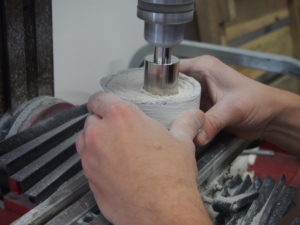ASTM C1556 determines the diffusion coefficient of chloride in concrete.

To predict the service life of concrete in a corrosive environment, you need to know the diffusion coefficient. ASTM C1556 is one way to measure that.
For new concrete, we use 4 inch x 8 inch cylinders that have cured for 28 days. We cut the top 3 inches and coat all but the top surface with epoxy. We condition the sample in lime water and then soak it in a sodium chloride solution for at least 35 days (longer for high-performance concrete).
Then we mill off 1-mm layers of the sample, analyzing each one for chloride ion content. We plot the concentration against the distance from the surface and use least squares regression analysis to calculate the diffusion coefficient.
In evaluating existing structures such as parking garages, we take cores and sample them in the same way.
ASTM C1556 and NT Build 492 are slightly different measures of the diffusion coefficient of chloride ions in concrete. For new concrete, NT Build 492 is much faster because it doesn’t require a lengthy exposure period. For existing concrete, the service environment has already provided the necessary exposure to chlorides.
